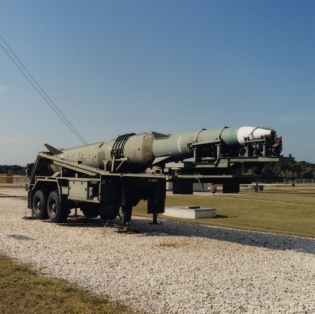
Overview
Display location:
- Hangar C, Cape Canaveral Space Force Station
Type: Surface-to-surface guided missile
Designation: MGM-31C
Serial Number: J645
Payload: Nuclear warhead
Agency: U.S. Army
Contractor: Martin Marietta
Cape Canaveral Air Force Station Operations: 1982-1988
History
Based on the Pershing I and IA missiles, the Pershing II contained technological and operational improvements that resulted in greater range and accuracy. The accuracy was improved by the use of a new radar area correlation guidance system that compared incoming targets with images recorded on its computer memory.
Since the Pershing II was so much more accurate than earlier versions, it was considered capable of causing at least as much damage to a specific target while carrying a smaller warhead.
The first Pershing II test launch occurred on 22 July 1982 at Cape Canaveral Space Force Station Launch Complex 16. A total of six Pershing IIs were launched in just one day, setting the record for land-based same-day launches at the Cape.
Treaty with Russia
In 1987, U.S. President Ronald Reagan and Soviet Premier Mikhail Gorbachev signed the Intermediate Nuclear Forces (INF) Treat that called for a ban of all land-based intermediate-range missiles, including the Pershing II.
All existing Pershing II missiles were to be dismantled and destroyed. A few were allowed to be rendered inert by filling them with concrete and putting them on public display, such as the one in the museum rocket garden. To satisfy the terms of the treaty, this exhibit is subject to random Russian inspection.